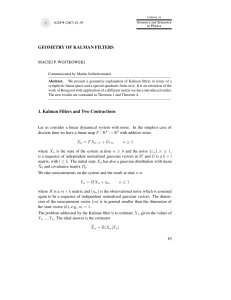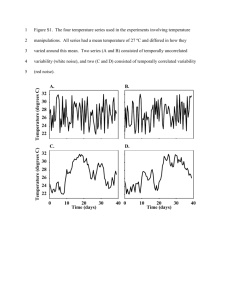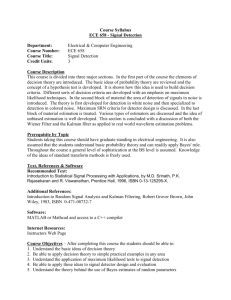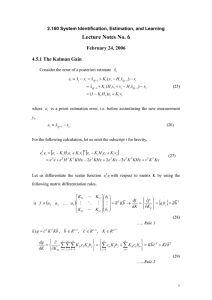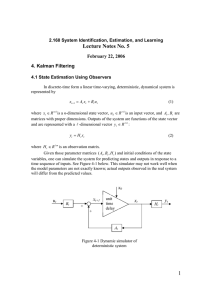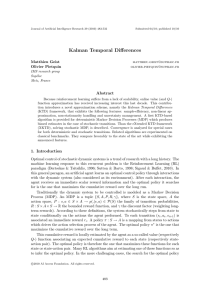Massachusetts Institute of Technology Department of Mechanical Engineering
advertisement
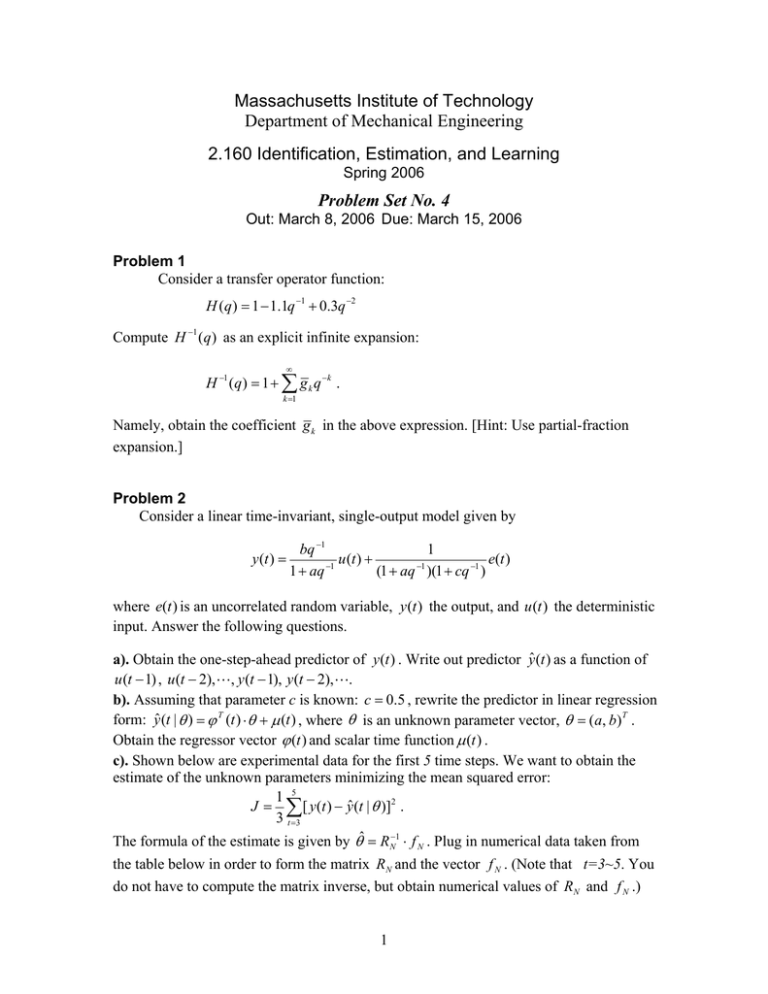
Massachusetts Institute of Technology Department of Mechanical Engineering 2.160 Identification, Estimation, and Learning Spring 2006 Problem Set No. 4 Out: March 8, 2006 Due: March 15, 2006 Problem 1 Consider a transfer operator function: H (q) = 1−1.1q −1 + 0.3q −2 Compute H −1 (q) as an explicit infinite expansion: ∞ H −1 (q) = 1+ ∑ g k q −k . k =1 Namely, obtain the coefficient g k in the above expression. [Hint: Use partial-fraction expansion.] Problem 2 Consider a linear time-invariant, single-output model given by y(t) = bq −1 1 u(t) + e(t) −1 −1 1+ aq (1+ aq )(1+ cq −1 ) where e(t) is an uncorrelated random variable, y(t) the output, and u(t) the deterministic input. Answer the following questions. a). Obtain the one-step-ahead predictor of y(t) . Write out predictor ŷ(t) as a function of u(t −1) , u(t − 2),", y(t −1), y(t − 2),". b). Assuming that parameter c is known: c = 0.5 , rewrite the predictor in linear regression form: ŷ(t | θ ) = ϕ T (t) ⋅ θ + µ (t) , where θ is an unknown parameter vector, θ = (a, b) T . Obtain the regressor vector ϕ (t) and scalar time function µ (t) . c). Shown below are experimental data for the first 5 time steps. We want to obtain the estimate of the unknown parameters minimizing the mean squared error: 1 5 J = ∑ [ y(t) − ŷ(t | θ )]2 . 3 t =3 The formula of the estimate is given by θˆ = R −1 ⋅ f . Plug in numerical data taken from N N the table below in order to form the matrix RN and the vector f N . (Note that t=3~5. You do not have to compute the matrix inverse, but obtain numerical values of RN and f N .) 1 t u(t) y(t) 1 2 0.00 2 4 0.00 3 10 1.00 4 8 1.50 5 6 1.05 Problem 3 A discrete-time Kalman filter is applied to location estimation of an autonomous vehicle. The state equation and measurement equation of the system are given by xt+1 = A ⋅ xt + wt yt = H ⋅ xt + vt where xt ∈ R nx1 , yt ∈ R Ax1 , wt ∈ R nx1 , vt ∈ R Ax1 , A ∈ R n×n , and H ∈ R Axn . Experiments were conducted to identify the characteristics of both process noise wt and measurement noise vt . It turns out that: • The process noise can be treated as zero-mean value, uncorrelated (white) noise: ∀t ≠ s 0 T E[ wt ] = 0 , and E[ wt ⋅ ws ] = ∀t = s Q • The measurement noise, too, can be treated as zero-mean value, uncorrelated (white) noise: ∀t ≠ s 0 T E[vt ] = 0 , and E[vt ⋅ vs ] = , but ∀t = s R • The process noise and the measurement noise are correlated to each other, since both process and measurement system are disturbed by the same source, i.e. the uneven road surface, so that: ∀t ≠ s − 1 0 T E[ wt ⋅ vs ] = . ∀t = s − 1 C T Note that vt is correlated with wt −1 alone: E[wt −1vt ] = C ∈ R nxA . The standard Kalman filter, where the process noise and the measurement noise are assumed to be uncorrelated, must be modified for this system. Answer the following questions. a). Let ε t be a priori state estimation error, ε t ≡ x̂t t −1 − xt . Compute the correlation between the a priori error and the measurement noise: T E[ε t vt ] . 2 b). Obtain the modified Kalman gain as a function of matrices R, Q, C , A, H , and the covariance matrix Pt|t−1 = E[ε t ε t ] . Use the following equation that is obtained by T differentiating the squared a posteriori error of state estimation, et = x̂t − xt : 1 d T T T T T T T et et = K t Hε t ε t H T −[K t Hε t vt + K t vt ε t H T ] + K t vt vt + [ε t vt − ε t ε t H T ]. 2 dK Problem 4 Consider a single-input, single-output linear time invariant system with no process noise: x = f ⋅ x (1) y = 2x + v(t) where f is parameter, y is output, and v(t) is uncorrelated measurement noise with variance R = 2. E[v(t)v(s)T ] = Rδ (t − s), δ (t − s) = Dirac's delta function (2) Answer the following questions. a). Obtain the Riccati differential equation associated with the Kalman filter of the above system. b). Obtain the steady-state solution P∞ of the Riccati equation, which is usable for the Kalman gain. Note that the answer is different depending on the stability of the system. Obtain P∞ for each of the following cases: the system of eq.(1) is i) stable, ii) unstable, and iii) marginally stable. c). Solve the Riccati differential equation with an initial condition of P(0) = P0 > 0 , and show that its solution converges to the steady-state solution in Part b). 3


